|
|
www.morokulien.de |
 Morokulien
MorokulienThe Scandinavian Republic of Peace
In Scandinavia, right on the border between Sweden and Norway, lies Morokulien (Morokulia). Morokulien often is called a "country", which it certainly is because of the geographical demarcation from Norway and Sweden. However, Morokulien is no nation in terms of the international law. Morokulien is about 6 hectares in size. Morokulien is a peace memento to Norwegians and Swedish, but is moreover a peace message to the world.
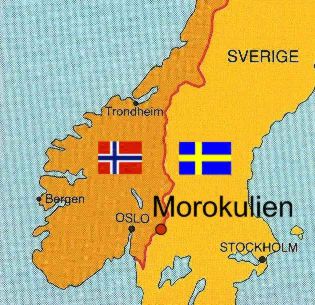 |
|
For at least 3 reasons Morokulien is interesting:
As an exemplary symbol of the peace between two neighbouring countries,
to philatelists because of the postmark "Morokulien",
Since 1380 Norway was ruled by Denmark. The Danish kings used to be also the kings of Norway. During the Napoleonic Wars, Norway was handed over to its neighbour Sweden in 1814. The Norwegian parliament however declared the independence of Norway and worked out a democratic constitution. In a 14-days war Sweden occupied its obstinate neighbour, but soon the Swedish crown prince Carl Johan approved the Norwegian constitution. Since then, 1814, both countries formed a political union. The Norwegian parliament proclaimed Carl Johan as King of Norway. In the period following, there arose however conflicts between the self-confident reform-orientated Norwegian Parliament (Storting) and Sweden.
In 1905, after new conflicts with Sweden, the Norwegian parliament offered the crown to the Danish prince Carl. Beforehand the parliament had dismissed the Swedish king Oscar II from Norway's crown. After more than 500 years the Norwegians obtained a king of their own again. Prince Carl became Norwegian and changed his name to Håkon VII. The last Norwegian king was Håkon VI Magnusson, who died in 1380. Sweden reacted on this 'arrogance' with preparations for a war. The marine moved to the Swedish west coast, and an attack onto Kristiania (1925 renamed to Oslo) was in initialisation. However, times had changed, and not all Swedish supported an attack onto their Norwegian neighbour. The Swedish peace movement was working hard to avoid a military conflict. In the end, the movement succeeded. Demonstrations and public appeals resulted in the Swedish government relenting. Negotiations were begun in Karlstad. On October 26, 1905, the independence of Norway was finally accepted by the Swedish government. A demilitarised zone was created along the the Swedish-Norwegian border. This zone was pacified and no fortifications, military harbours or suppliers were allowed. Morokulien lies in this zone.
 Since
that year 1905 the Swedish peace movement SPAS (Swedish Peace and Arbitration
Society) has held annual peace conferences. In 1911, at the Östersund
conference, it was proposed to erect a monument in honour of the long period
of peace (since 1814). This monument should – if possible –
be ready by the 100th anniversary in 1914. In 1913 a place was found: in-between
the demilitarised zone, right on the border between Sweden and Norway. The
peace activists in Norway and in Sweden started collecting money for the monument.
While the Norwegians were quite generous, the activists encountered some restraints
in Sweden. Many Swedish still considered the release of Norway as a humiliation.
Nevertheless, literally walking from door to door, the Swedish peace activists
managed to collect 17.000 crowns. Also the governments of both countries were
asked for a contribution of 2000 crowns. The Norwegian parliament approved
the request immediately. The Swedish government was indecisive. Only after
the monument was inaugurated the contribution was granted by the parliament
with a vote of 194 pro's against 156 contra's. The peace between Norway and
Sweden used to be not self-evident yet.
Since
that year 1905 the Swedish peace movement SPAS (Swedish Peace and Arbitration
Society) has held annual peace conferences. In 1911, at the Östersund
conference, it was proposed to erect a monument in honour of the long period
of peace (since 1814). This monument should – if possible –
be ready by the 100th anniversary in 1914. In 1913 a place was found: in-between
the demilitarised zone, right on the border between Sweden and Norway. The
peace activists in Norway and in Sweden started collecting money for the monument.
While the Norwegians were quite generous, the activists encountered some restraints
in Sweden. Many Swedish still considered the release of Norway as a humiliation.
Nevertheless, literally walking from door to door, the Swedish peace activists
managed to collect 17.000 crowns. Also the governments of both countries were
asked for a contribution of 2000 crowns. The Norwegian parliament approved
the request immediately. The Swedish government was indecisive. Only after
the monument was inaugurated the contribution was granted by the parliament
with a vote of 194 pro's against 156 contra's. The peace between Norway and
Sweden used to be not self-evident yet.
The place at which the monument was about to be erected belonged to the peace movements in Norway (the Norwegian Peace League) and Sweden (SPAS). All people involved in the project worked on a voluntary basis or for symbolic payment. The Norwegian state railway transported the granite blocks for free. The Swedish architect Lars Johan Lehming designed the monument without charge. But as 'thanks' for his work, he was fired from his job at the defence bureau.
The monument is made of white granite. On top of the pillars – one pillar on Swedish ground, the other one on Norwegian ground – two men are standing on each side of the national border and reaching each other a friendly hand: "Independent but sprung from common ground". The total costs for the monument summed up to 26.500 Swedish crowns.
 |
Inscription: NORSKE • OG • SVENSKE MONUMENT • 1914 • MED • TAK FÖR • HUNDREAARIG • FRED |
Translation: Norwegian and Swedish peace activists built this monument 1914 with thanks for 100 years of peace |
On August 16th of the year 1914 – 100 years after the last incident between Sweden and Norway – the monument finally was inaugurated. It was a sunny day with azure sky. White flags fluttered around the proud monument, and along the border line there were Norwegian and Swedish flags to be seen. Trains from both directions pulled by while Norwegian and Swedish bands were playing music. Instead of expected 3.000 people, finally around 12.000 guests showed up. Food and drink soon vanished, and at the end of the day even the wells went dry by the the thirsty visitors. In the crowd could be seen some sixty Norwegian MPs, but only 10 from Sweden. The main Swedish speakers were bishop van Scheele and Carl Sundblad (SPAS). The most prominent Norwegian speaker was the speaker of the house J. Lövland. However, one event drew its dark shadows across the ceremony: While the people here celebrated the peace, the beginnings of the World War I took their course in central Europe.
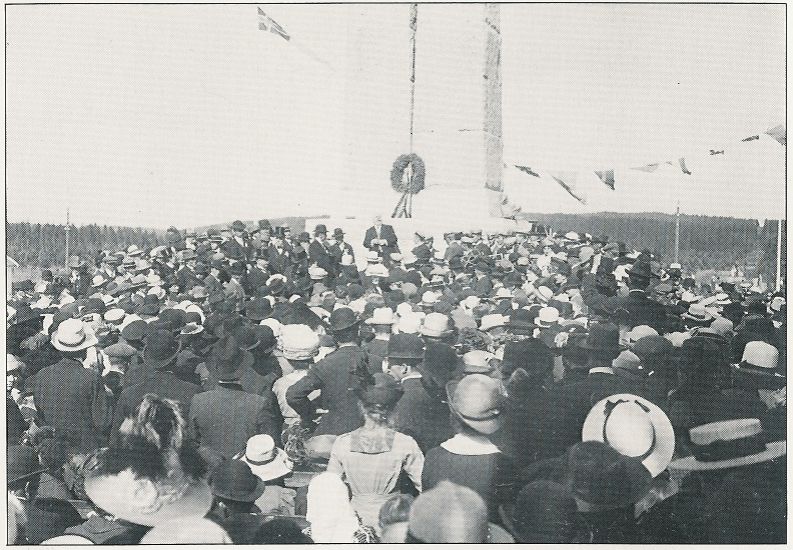 |
| Opening ceremony on August 16th, 1914 (image taken from [1]) |
Ever since the inauguration in 1914, the peace monument has been a gathering place for Scandinavian meetings. During World War II it was the only place where a Swedish-Norwegian couple could get married. Even today Scandinavian marriages take place here. Many well-known speakers and artists have taken part in the numerous meetings held by the monument. As an example, short after the war in 1945, around 13.000 people came to listen to Folke Bernadotte talking about his work with prisoners of war in Germany.
 In
1959 Swedish and Norwegian broadcasting corporations borrowed the monument
grounds in order to send a series of programs "Beyond all Boundaries".
The year 1959 had been declared the "International Refugee Year"
by the United Nations, and the peace monument become internationally well-known.
Lennart Hyland, a popular radio and TV personality, coined
the name for the area: "Morokulia", which is a combination of the
Norwegian and Swedish words for "fun". Since then, the 6ha area
is known as Morokulien. The SPAS has proclaimed Morokulien a "Republic
of Peace".
In
1959 Swedish and Norwegian broadcasting corporations borrowed the monument
grounds in order to send a series of programs "Beyond all Boundaries".
The year 1959 had been declared the "International Refugee Year"
by the United Nations, and the peace monument become internationally well-known.
Lennart Hyland, a popular radio and TV personality, coined
the name for the area: "Morokulia", which is a combination of the
Norwegian and Swedish words for "fun". Since then, the 6ha area
is known as Morokulien. The SPAS has proclaimed Morokulien a "Republic
of Peace".
A post office was opened in the new "republic". From this small republic letters can be stamped with three postmarks: Norwegian, Swedish and Morokulian postmark. This is the only place where you legally can post letters with stamps from two countries. Even the combination of a Norwegian and Swedish stamp is allowed. The post mark "Morokulien" still sounds mystical to philatelists of the world.
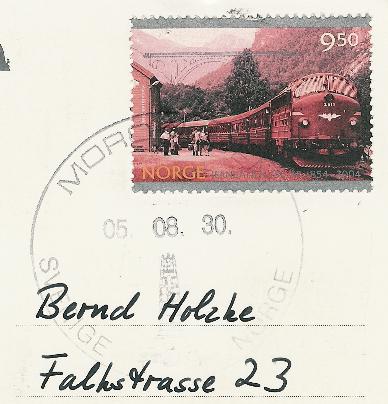 |
Postmark Morokulien, August 30th, 2005. The postmark contains the words MOROKULIEN, SVERIGE, NORGE (barely
readable). The peace monument is stylised. The date is given in the
format |
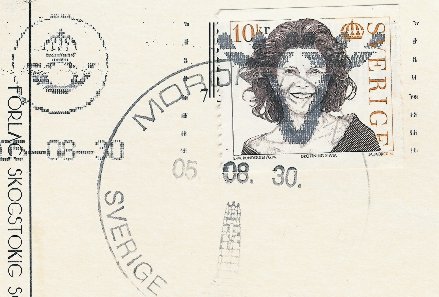 |
Postmark Morokulien, August 30th, 2005. The postmark is the same as above. This card was dropped in the Swedish letter box and has then been delivered by the Swedish post – as can be seen from the small postmark on the left (post horn with crown). Moreover, the province Värmland has left its mark (the stylised elk head) on the stamp.
|
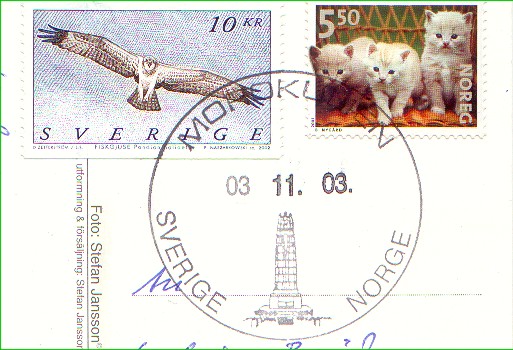 |
Sent by Axel, DL7ULF: A post card with the stamps of the two countries. The card is stamped on Nov 11th, 2003. The country name on the Norwegian stamp is given in New-Norwegian language. NOREG = Norway (Ny-Norsk, New-Norwegian language) |
Tourist organisations from Norway and Sweden started a tourist bureau. The first bureau was located in the old "Brennstua", later the bureau moved close to the Värdshus (the inn). The new tourist bureau has been placed centred on the border between Sweden and Norway. The entrance directly lies on the border line between the two countries (the slit between the doors is the national border). On the left side of the entrance is placed the Swedish letter box, on the right side the Norwegian.
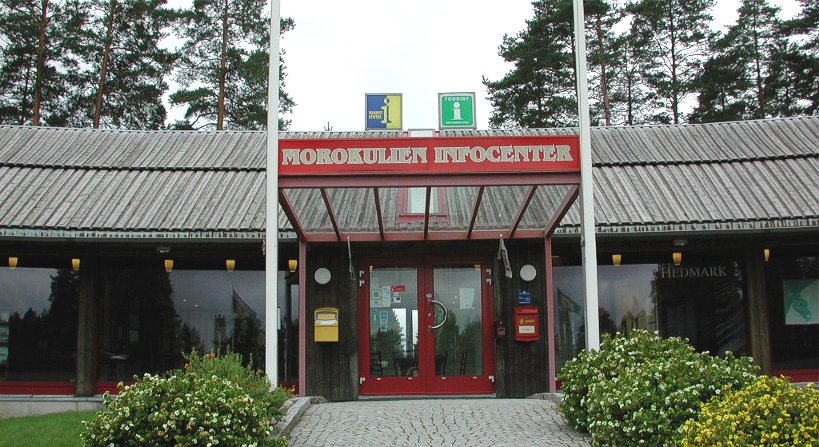 |
| The tourist bureau lies directly on the national border between Sweden (left) and Norway (right) |
One may – symbolically – become a citizen of Morokulien. A Morokulien passport can be purchased. Morokulien thus has citizens, but no inhabitants (maybe to the exception of the owner of the camping ground or of the inn). The citizenship may be considered a touristic gag, but the underlying idea (initiated by SPAS) is to gain people from all over the world for the idea of peace.
Close to the border, on the Norwegian side, is located a cottage. It is called "Grensstua" (border cottage), and it used to be the building closest to the border (before the new tourist centre was built right on the border). Since many years the cottage contains an amateur radio station. Licensed radio amateurs may carry the idea of Morokulien to the world.
[1] "The Peace Monument — A Milestone in History", Booklet, published by the "Swedish Peace and Arbitration Society" (SPAS), Brännkyrkagatan 76, 11723 Stockholm. The booklet is available for free at the Morokulien Infocenter (tourist bureau).
[2] Harenberg Staatenlexikon, Edition 2000, Harenberg Lexikon Verlag, Dortmund (Germany), ISBN 3-611-00894-X, www.harenberg.de.
| Impressum | Disclaimer |
Created: Sep 09, 2005 Last change: May
30, 2006 DL6BZ |